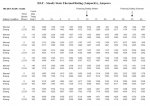mbrooke
Batteries Included
- Location
- United States
- Occupation
- Technician
What is the maximum operating temperature of ACSR before damage, creep or none elastic deformation occurs?
https://www.southwire.com/ProductCatalog/XTEInterfaceServlet?contentKey=prodcatsheet16
Apathetic of sag, the continuous operating limit I frequently see 140*C with 200*C reserved for short time emergencies. Second why does the Southwire chart calculate amps at 75*C when loss of strength does not occur above 100*C?
https://www.southwire.com/ProductCatalog/XTEInterfaceServlet?contentKey=prodcatsheet16
Apathetic of sag, the continuous operating limit I frequently see 140*C with 200*C reserved for short time emergencies. Second why does the Southwire chart calculate amps at 75*C when loss of strength does not occur above 100*C?


